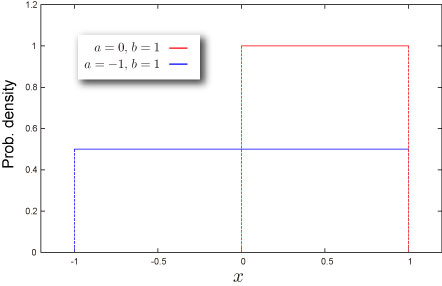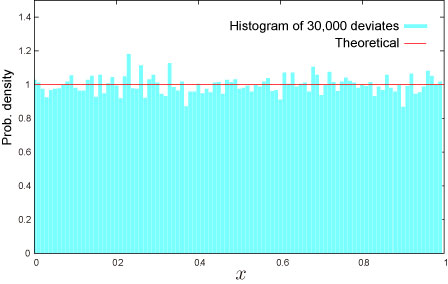Uniform distribution (Continuous)
Where will you meet this distribution?
- Generating random numbers according to a desired distribution
- Digital signal processing (dithering) – digital audio, digital video, digital photography, seismology, RADAR, weather forecasting systems and many more
Shape of Distribution
Basic Properties
- Two parameters
are required.
These parameters are minimum and maximum value of variable respectively.
- Continuous distribution defined on bounded range
- This distribution is always symmetric.
Probability
- Cumulative distribution function
- Probability density function
- How to compute these on Excel.
1 2 3 4 5 6 7 A B Data Description 0.5 Value for which you want the distribution 1 Value of parameter A 5 Value of parameter B Formula Description (Result) =(A2-A3)/(A4-A3) Cumulative distribution function for the terms above =1/(A4-A3) Probability density function for the terms above 
Quantile
- Inverse of cumulative distribution function
- How to compute this on Excel.
1 2 3 4 5 6 A B Data Description 0.5 Probability associated with the distribution 1 Value of parameter A 5 Value of parameter B Formula Description (Result) =A3+A2*(A4-A3) Inverse of the cumulative distribution function for the terms above
Characteristics
Mean – Where is the “center” of the distribution? (Definition)
- Mean of the distribution is given as
- How to compute this on Excel
1 2 3 4 5 A B Data Description 8 Value of parameter A 2 Value of parameter B Formula Description (Result) =(A2+A3)/2 Mean of the distribution for the terms above
Standard Deviation – How wide does the distribution spread? (Definition)
- Variance of the distribution is given as
Standard Deviation is a positive square root of Variance.
- How to compute this on Excel
1 2 3 4 5 A B Data Description 8 Value of parameter A 2 Value of parameter B Formula Description (Result) =(A3-A2)/(2*SQRT(3)) Standard deviation of the distribution for the terms above
Skewness – Which side is the distribution distorted into? (Definition)
- Skewness is
Kurtosis – Sharp or Dull, consequently Fat Tail or Thin Tail (Definition)
- Kurtosis is
Random Numbers
- Random number x is generated from uniform random U,
- How to generate random numbers on Excel.
1 2 3 4 5
A B Data Description 1 Value of parameter A 5 Value of parameter B Formula Description (Result) =(A3-A2)*NTRAND(100,A2,A3,0)+A2 100 uniform deviates based on Mersenne-Twister algorithm for which the parameters above Note The formula in the example must be entered as an array formula. After copying the example to a blank worksheet, select the range A5:A104 starting with the formula cell. Press F2, and then press CTRL+SHIFT+ENTER.

NtRand Functions
- Generating random numbers based on Mersenne Twister algorithm: NTRAND
Reference
- Wolfram Mathworld – Uniform Distribution
- Wikipedia – Uniform distribution (continuous)
- Statistics Online Computational Resource

 RSS
RSS
